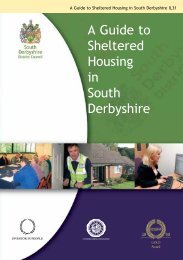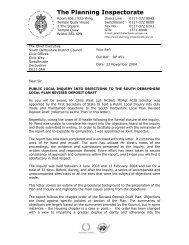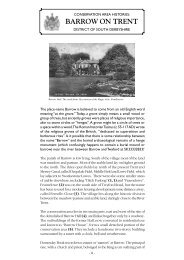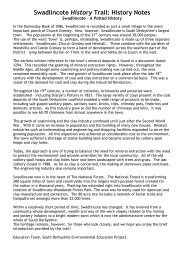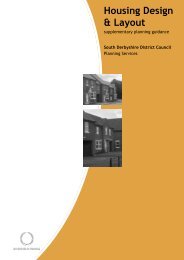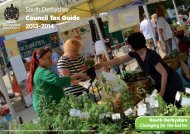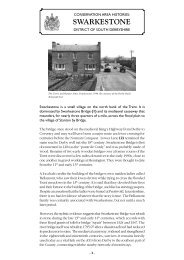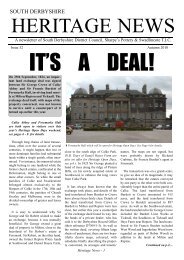Heritage News 19 - South Derbyshire District Council
Heritage News 19 - South Derbyshire District Council
Heritage News 19 - South Derbyshire District Council
You also want an ePaper? Increase the reach of your titles
YUMPU automatically turns print PDFs into web optimized ePapers that Google loves.
HISTORIC BUILDINGS - NEW LISTINGS<br />
Four new buildings have been added to the register<br />
of listed buildings within <strong>South</strong> <strong>Derbyshire</strong> in the<br />
last nine months. A request for a building to be listed<br />
can be made by any member of the public, or by a<br />
body such as the <strong>District</strong> <strong>Council</strong>, which in practice<br />
currently submits most of the requests that are made<br />
from <strong>South</strong> <strong>Derbyshire</strong>.<br />
The responsibility for listing buildings lies with the<br />
Department for Culture, Media and Sport in London,<br />
which takes the advice of English <strong>Heritage</strong> officers<br />
as to whether a building should be listed or not.<br />
The newly-listed buildings comprise:<br />
Sealwood Cottage, Sealwood Lane, Linton<br />
(listed 25 th August, 2004).<br />
This is an intriguing, folly-like, “gothick” cottage of the<br />
late 18 th century which stood on the edge of Seal Wood,<br />
commanding a wide view towards Overseal. The<br />
woodland around the cottage has long since been felled.<br />
The cottage, built by the Gresleys of Netherseal<br />
apparently for their own use, is of a highly unusual cavity<br />
wall construction, with re-used oak timber framing to the<br />
outer leaf of the walls, and solid brickwork to the inner<br />
leaf.<br />
The Woodville War Memorial, of Cornish granite with a<br />
bronze plaque, dates from <strong>19</strong>25-26. Many war<br />
memorials are not listed buildings, but one of the reasons<br />
for listing this one was its unusual inscription: “Erected<br />
to the memory of the late Mr. W. Cousens who for 30<br />
years was the much esteemed head master of the<br />
Wesleyan School of the village, and his scholars who<br />
paid the supreme sacrifice in the Great War <strong>19</strong>14-<strong>19</strong>18”.<br />
Below is the list of 130 men, including 77 scholars, who<br />
were killed in action. On the reverse are the names of<br />
those who fell in the Second World War <strong>19</strong>39-<strong>19</strong>45.<br />
Escolme Pottery, Woodville<br />
(listed 21 st February, 2005).<br />
Originally, the house had just a single room downstairs<br />
and a single room upstairs, reached by a pretty, winding<br />
staircase. The upstairs room was evidently a “prospect<br />
room”, featuring a fine fireplace, large window, pyramidal<br />
ceiling ... and an original bedframe which slides out of<br />
the dado from a void in the roof space! A modest<br />
extension was made to the house in the Victorian period.<br />
Woodville War Memorial<br />
(listed 30 th March, 2005).<br />
•The Escolme Pottery, Woodville<br />
By a coincidence, this building is only a few yards away<br />
from the one previously mentioned. The new listing<br />
comprises the one remaining bottle kiln of the pottery,<br />
dated “1833” in blue headers on the top courses,<br />
together with the workshops to the south west of the<br />
kiln. This was the only bottle kiln within the area of the<br />
former Swadlincote potteries that was not already listed.<br />
There are now nine listed examples in the area<br />
altogether. The others comprise a group of four kilns at<br />
the T. G. Green pottery, plus single examples at the<br />
former “top bank” of T. G. Green’s, Sharpe’s Pottery<br />
(Swadlincote), Rawdon Pottery (behind the Clock<br />
Garage at Woodville) and at Bretby Brick and Stoneware<br />
Co.<br />
Phone Box, Main Street, Milton<br />
(listed 10 th January, 2005).<br />
Not all listed buildings are built of bricks, stone or mortar.<br />
Cast iron mileposts and, yes, cast iron phoneboxes, are<br />
equally eligible. In practice, telephone boxes are more<br />
likely to be deemed “listable” where they form part of<br />
the streetscene in a “good heritage location” such as a<br />
conservation area, as the Milton one does. This red<br />
telephone box, of the friendly and familiar type that was<br />
once ubiquitous, was designed by Sir Giles Gilbert Scott<br />
and made by various manufacturers.<br />
•The Woodville War Memorial.<br />
<strong>Heritage</strong> <strong>News</strong> - 6



